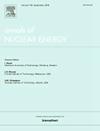Analysis of the modal characteristics of NHR200-II fuel rods in turbulent axial flow
IF 1.9
3区 工程技术
Q1 NUCLEAR SCIENCE & TECHNOLOGY
引用次数: 0
Abstract
The dynamics of vibrating fuel rods under axial fluid flows in a 200 MW nuclear heating reactor (NHR200-II) was analyzed through Fluid-Structure Interaction (FSI) simulations. Various inflow velocities and turbulence inlet conditions were considered to assess their influence on the system’s modal properties. The turbulent fluid flow was modelled by Unsteady Reynolds-Averaged Navier–Stokes (URANS) approach, while the rod was treated as an elastic solid. Numerical simulations were conducted utilizing the two-way coupling FSI solver in the commercial code LS-DYNA. The computational results indicate that the vibrating frequency remains largely insensitive to inflow velocities ranging from 0 to 6 m/s, whereas modal damping ratio increases with higher velocities. Turbulence inlet conditions were found to have a negligible effect on rod vibrations in specified inflow velocities. Furthermore, the added mass and damping for an inflow velocity of 1.0 m/s were evaluated as a demonstration and successfully integrated into the relevant structural solver.
求助全文
约1分钟内获得全文
求助全文
来源期刊

Annals of Nuclear Energy
工程技术-核科学技术
CiteScore
4.30
自引率
21.10%
发文量
632
审稿时长
7.3 months
期刊介绍:
Annals of Nuclear Energy provides an international medium for the communication of original research, ideas and developments in all areas of the field of nuclear energy science and technology. Its scope embraces nuclear fuel reserves, fuel cycles and cost, materials, processing, system and component technology (fission only), design and optimization, direct conversion of nuclear energy sources, environmental control, reactor physics, heat transfer and fluid dynamics, structural analysis, fuel management, future developments, nuclear fuel and safety, nuclear aerosol, neutron physics, computer technology (both software and hardware), risk assessment, radioactive waste disposal and reactor thermal hydraulics. Papers submitted to Annals need to demonstrate a clear link to nuclear power generation/nuclear engineering. Papers which deal with pure nuclear physics, pure health physics, imaging, or attenuation and shielding properties of concretes and various geological materials are not within the scope of the journal. Also, papers that deal with policy or economics are not within the scope of the journal.
 求助内容:
求助内容: 应助结果提醒方式:
应助结果提醒方式:


